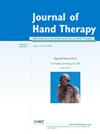Effect of splinting and kinesiotaping treatments on functional status, sleep quality and median nerve cross-sectional area in carpal tunnel syndrome: A single blind prospective randomized controlled study
IF 1.8
4区 医学
Q2 ORTHOPEDICS
引用次数: 0
Abstract
Background
The effect of conservative treatments on sleep quality in carpal tunnel syndrome is unclear.
Purpose
Comparing the effect of splinting and kinesiotaping in carpal tunnel syndrome on functional status, pain, grip strength, nerve cross-sectional area and sleep quality.
Study Design
Randomized controlled study.
Methods
The participants were divided into three groups. One group was given night splint and nerve tendon gliding exercises, one group was given kinesiotaping and nerve tendon gliding exercises and one group was given only nerve tendon gliding exercises. The participants was evaluated with Visual Analog Scale (VAS), Boston Carpal Tunnel Syndrome Questionnaire, Pittsburgh Sleep Quality Index (PSQI), Jamar hand dynamometer, ultrasonography by a blind investigator in the treatment group at baseline and at 3 months.
Results
A total of 90 participants, 53 women and 37 men, with a mean age of 47.6 ± 10.5, participated in the study. The decrease in Boston symptom severity and functional status scores was higher in the kinesiotaping group than in the splint group (Cohen's d = −0.78). A statistically significant decrease was found in PSQI scores in all groups (p < 0.05). A statistically significant decrease was found in the PSQI total and sleep duration component score in the kinesiotaping group compared to the splint group and the exercise group (Cohen's d = 0.69).
Conclusions
Both splinting and kinesiotaping are effective on pain, functional status, hand grip strength and median nerve cross-sectional area. This effect is greater in kinesiotaping. Splinting, kinesiotaping and nerve tendon gliding exercises treatments are effective in improving sleep quality, but this effect is greater in kinesiotaping. ClinicalTrials.gov ID: NCT06514625.
夹板和运动胶带治疗对腕管综合征功能状态、睡眠质量和正中神经横截面积的影响:一项单盲前瞻性随机对照研究。
背景:保守治疗对腕管综合征患者睡眠质量的影响尚不清楚。目的:比较夹板和运动带对腕管综合征患者功能状态、疼痛、握力、神经截面积和睡眠质量的影响。研究设计:随机对照研究。方法:将受试者分为三组。1组给予夜间夹板和神经腱滑翔运动,1组给予运动胶带和神经腱滑翔运动,1组只给予神经腱滑翔运动。治疗组在基线和3个月时采用视觉模拟量表(VAS)、波士顿腕管综合征问卷(Boston Carpal Tunnel Syndrome Questionnaire)、匹兹堡睡眠质量指数(PSQI)、Jamar手测力仪(hand dynamometer)、盲测者超声检查对患者进行评估。结果:共纳入90例患者,其中女性53例,男性37例,平均年龄47.6±10.5岁。运动胶带组波士顿症状严重程度和功能状态评分的下降高于夹板组(Cohen’s d=-0.78)。各组患者PSQI评分均有显著降低(p)。结论:夹板和运动固定术对疼痛、功能状态、手部握力和正中神经横截面积均有效。这种效果在运动磁带中更明显。夹板、运动胶带和神经腱滑动运动治疗对改善睡眠质量有效,但运动胶带的效果更大。临床试验:gov ID: NCT06514625。
本文章由计算机程序翻译,如有差异,请以英文原文为准。
求助全文
约1分钟内获得全文
求助全文
来源期刊

Journal of Hand Therapy
医学-外科
CiteScore
3.50
自引率
10.00%
发文量
65
审稿时长
19.2 weeks
期刊介绍:
The Journal of Hand Therapy is designed for hand therapists, occupational and physical therapists, and other hand specialists involved in the rehabilitation of disabling hand problems. The Journal functions as a source of education and information by publishing scientific and clinical articles. Regular features include original reports, clinical reviews, case studies, editorials, and book reviews.
 求助内容:
求助内容: 应助结果提醒方式:
应助结果提醒方式:


